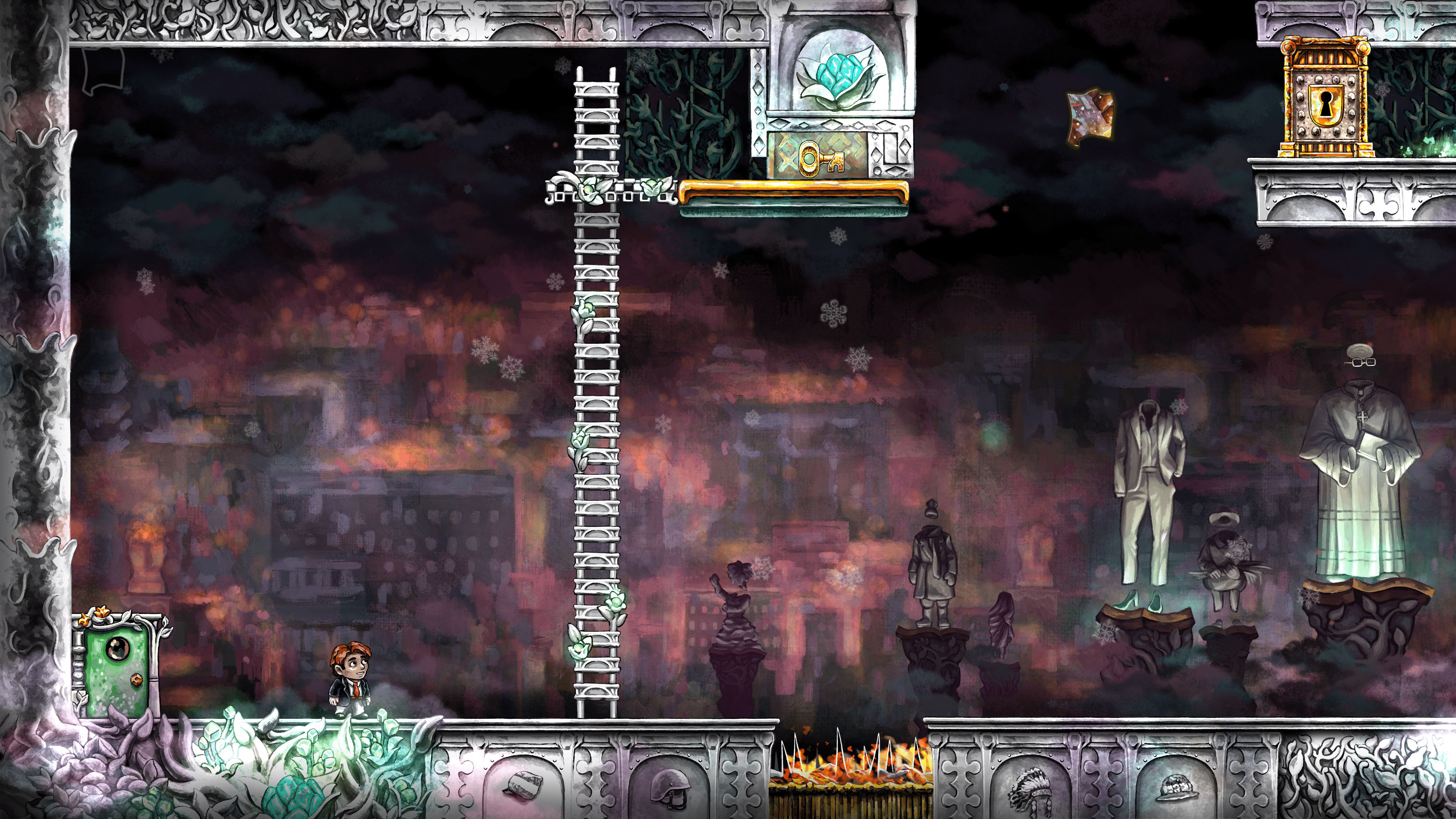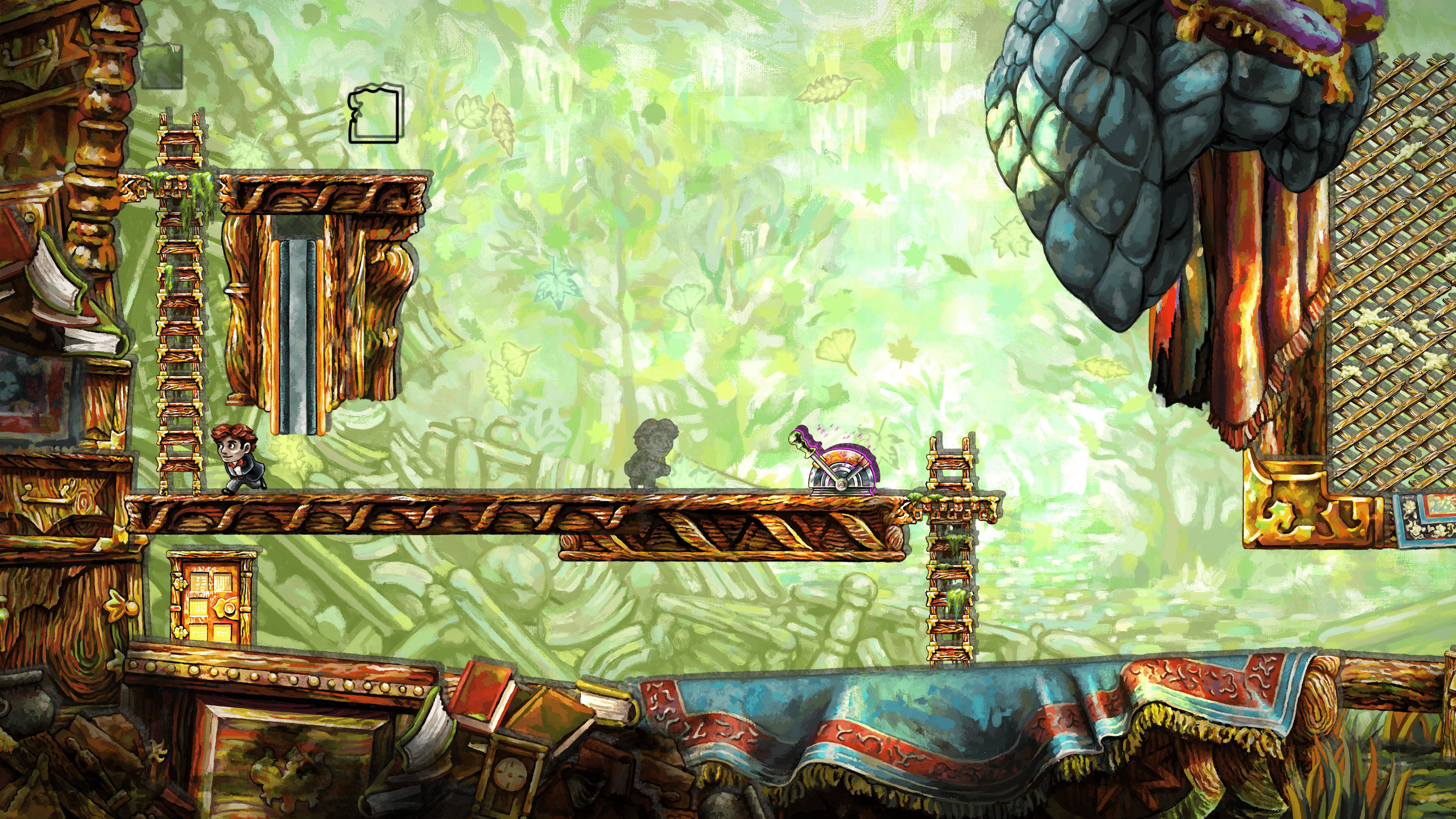*********
* Controls *
************
By default, the controls are: Arrow keys or W/A/S/D to move. Shift to rewind. X to toggle graphics and sound between the Anniversary Edition and the old version of the game.
***********
* Options *
***********
In Braid, Anniversary Edition, all common controls, graphics, and audio settings are available from the pause menu (Escape key):
Pause -> Options -> Remap Keyboard
Pause -> Options -> Remap Controller
Pause -> Options -> Game
Pause -> Options -> Graphics
Pause -> Options -> Audio
You can show the frame-rate and frame-time on-screen by pressing the '=' key. This key can be remapped in the options menu.
***************
* Saved Games *
***************
Your save-games, user settings, and log files can be found at:
On Windows -> C:\Users\<YOUR_USER_NAME>\AppData\Roaming\Braid, Anniversary Edition
or for short, you can type into the address bar of a folder: %APPDATA%
and then double-click on the Braid, Anniversary Edition folder there.
************************************
* Languages & Command-line Options *
************************************
There are a couple of useful command-line options. To use them you can put these arguments in the "Target" section of a
shortcut's properties, in the options of whatever store-front launcher (such as Steam) you're using, or run Braid from a command prompt.
Example:
braid64_d3d11_final.exe -windowed -language es_LA
(Run Braid in a window, with the language set to latin american spanish).
The options are:
-fullscreen : Run Braid full-screen.
-windowed : Run Braid in a window.
If you don't specify one of these options, you can switch between full-screen and windowed at runtime by pressing Alt-Enter,
or in the graphics options menu.
-language en : Set Language English
-language es_ES : Set language Spanish.
-language es_LA : Set language Spanish (Latin America).
-language de : Set language German.
-language fr : Set language French.
-language it : Set language Italian.
-language ja : Set language Japanese.
-language ko : Set language Korean.
-language pl : Set language Polish.
-language pt_PT : Set language Portuguese.
-language pt_BR : Set language Portuguese (Brazil).
-language ru : Set language to Russian.
-language zh_TW : Set language to Chinese (Traditional).
-language zh_CN : Set language to Chinese (Simplified).
-language id : Set language to Indonesian.
-language hu : Set language to Hungarian.
-language ar : Set language to Arabic.
If you don't use one of these language options, Braid will read the appropriate language setting from your OS, or from the
store-front launcher if you are using one.
**********************
* User Settings file *
**********************
The first time you run Braid, it'll create a user_settings.variables file at the saved games location. It's a text file you can
edit by hand, but most of the options in it can be controlled much more easily from the Graphics section of the pause menu.
There are a few extra to help future-proof the game and workaround graphics and performance issues:
"requested_fullscreen_mode":
-1 (default) Braid will choose the mode it thinks works best on your system.
0 Native fullscreen
1 Borderless windowed
2 Flip sequential. (Windows) On some versions of windows this will force vsync on in fullscreen.
:
You will see a line in the log.txt file similar to: "D3D11: fullscreen mode defaulted to 2." or "D3D11: fullscreen mode: user requested 0, got 0."
"requested_fullscreen_res" (Windows) for forcing lower resolutions and refresh rates when in fullscreen:
-1 (default) Braid will choose the fullscreen resolution and refresh rate. This will just be the current desktop settings, except on low-capability GPUs.
0 Use the current desktop resolution, but force the refresh rate to 60fps
1 Force the fullscreen resolution to 1080p (or the supported resolution closest to it) at 60fps
2 Force the fullscreen resolution to 1080p (or the supported resolution closest to it) at the current desktop refresh rate
3 Force the fullscreen resolution to 720p (or the supported resolution closest to it) at 60fps
4 Force the fullscreen resolution to 720p (or the supported resolution closest to it) at the current desktop refresh rate
5 Force Braid to always use the current desktop resolution and refresh rate, even on low capability GPUs
:
If the monitor doesn't support the requested mode, Braid will do it's best to pick something close, or will fall back on the default behaviour.
You will see a line in the log.txt file similar to: "D3D11: fullscreen resolution and refresh rate defaulted to match monitor."
"requested_gpu_index" (Windows) for choosing a specific GPU on multi-GPU systems if Braid can't get it right:
-1 (default) Braid will choose which GPU to use. On switcheable graphics systems (Optimus/Power Express) it will favor the discrete GPU
unless you've specified a choice in your driver setting, in which case it should use that.
0 (or higher) Choose a specific GPU using the indexes that show up in log.txt under the line "D3D11: Enumerating adapters".
:
If the specified index is too high or the adapter can't be used, you will see a line in the log.txt file similar to:
"D3D11: The user requested adapter 1 but it was not found, or had no outputs."
"requested_gpu_capability" (Windows) for forcing your GPU to be treated as being of a certain capability level, if Braid can't get it right:
-1 (default) Braid will evaluate the GPU and act accordingly
0 Force Braid to treat the GPU as low capability; e.g. as if it's an integrated GPU. This will lower graphical fidelity and might lock out some graphics options.
1 Force Braid to treat the GPU as high capability; e.g. as if it's a somewhat recent discrete graphics card. This can lead to poor performance or crashes if it isn't!
:
If you use this option, you will see a line in the log.txt file similar to: "D3D11: user is forcing GPU to be treated as having LOW capability."
===









